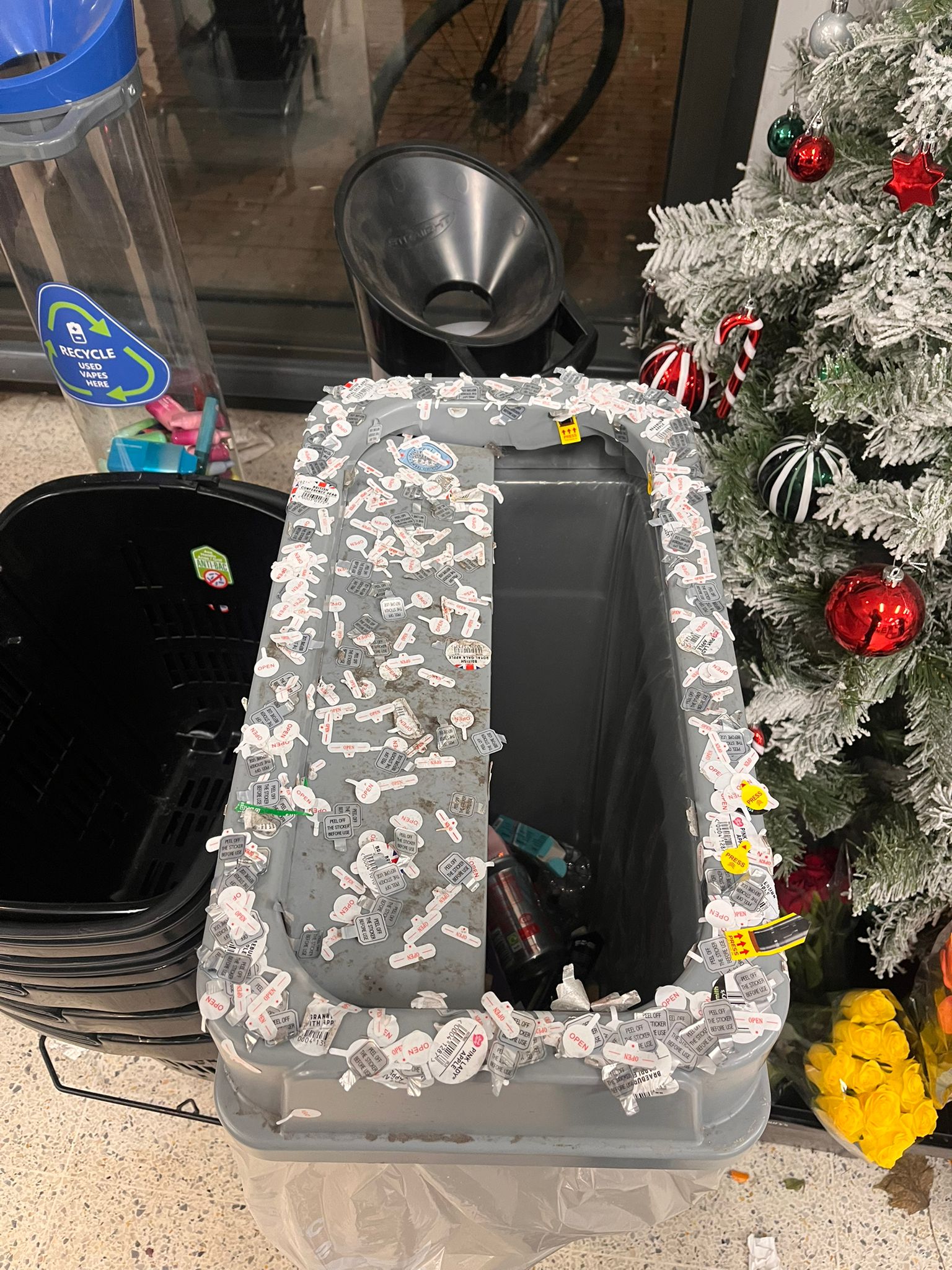As I sat down to write this article, I made sure all essentials were in place. Laptop charger, cup of tea, vape. I, like over a million Brits, have found myself occasionally reaching for an e-cigarette, part of a trend that has proliferated across the UK with astonishing speed. What began as an effective tool to quit smoking has, for many, become a regular habit for young and old alike, across almost all socioeconomic groups and professional and social settings.
During a recent visit back home to the UK, I was stunned to see just how visible the disposable vape culture has become. Every second person seemed to be vaping. Bankers rushed around London’s Canon Street gripping Lost Mary’s. Staff cowered from Bristol’s bitter winds in the hospital smoking area amongst plumes of artificial smoke. Directly outside a local Sainsbury’s, a rubbish bin was completely plastered with fresh disposable vape stickers. These tiny stickers are emblems of a growing waste crisis. It wasn’t just the sheer volume of these single-use devices that took me by surprise, but the casualness with which they were discarded. They were everywhere.
This seemingly innocuous trend masks a much larger problem. Discarded electricals are now among the fastest-growing sources of waste. In 2022, an estimated 62 million tonnes of e-waste were produced globally. According to the WHO, only 22.3 percent of this was documented as formally collected and recycled. The average Brit fairs slightly better, producing nine kilograms of e-waste each year of which 31.2 percent is recycled.
Still, there’s a long way to go. Every week, over eight million vapes are thrown away across the country. As we puff and toss, the consequences for our environment, our infrastructure and finite resources are mounting.
Step one: Reduce disposable vape numbers
While upcoming regulations aim to ban single-use vapes by June 2025 in the UK, the issue continues to escalate. Rates of e-cigarette use among adults who had never regularly smoked were stable until 2021, when roughly one in 200 Brits vaped, according to the Guardian. However, in 2024, that number increased sharply to one in 28, adding exponentially to the already seismic volume of waste produced. Likewise, many emerging products like “Big Puff” vapes remain outside of the ban’s scope. Environmental groups warn that these high-capacity vapes, despite being marketed as reusable, are often treated as disposable by consumers due to their low cost and poorly constructed rechargeable components that break after a few uses.
These discarded vapes then go on to leak harmful chemicals and plastics into the natural world, contaminating soil and water and putting wildlife at risk. Hidden inside many of these devices, lithium-ion batteries can become hazardous when crushed or compacted in rubbish bins and recycling centres. This is no small concern. Fires caused by crushed batteries, such as those in vapes, are increasingly common, putting waste management workers, equipment and facilities at serious risk.
Scott Butler is the Executive Director of Material Focus, a British not-for-profit organisation dedicated to creating a world in which materials are never wasted. “There have been 1,200 reported fires linked to batteries and electricals containing batteries.” He explained to RESET that the sheer volume of waste compounds these dangers. The millions of devices thrown away weekly mean millions of potential hazards putting humans, animals and infrastructure in jeopardy.
Poor resource use adds another layer to the crisis. Lithium, an essential component of renewable energy technologies and electric vehicles, is one of the most critical materials wasted when vapes are binned instead of recycled. Copper, plastics and other perfectly recyclable components also vanish into landfills. These lost resources mean ever more need to be extracted from the earth, fueling conflict and environmental degradation in some of the world’s poorest countries. All for a Blueberry Razz vape that lasts one weekend.
And finally, money. Currently, the cost of recycling a single vape stands at around 50p (60c), translating to £5,000 to £10,000 (€6,000 – €12,000) per tonne—the equivalent of about 37,000 vapes. In 2023, Material Focus estimated the potential cost of collecting and recycling vapes at £200 million (€241 million). The organisation argues that these expenses should be borne by vape producers, importers and retailers, rather than the taxpayer.
Step two: Filling gaps in awareness
Under UK law, vape retailers are legally required to accept used devices for recycling, free of charge. This take-back system offers consumers an easy way to ensure vital materials are recovered instead of wasted. However, while the infrastructure exists, awareness remains a barrier. 77 percent of UK users feel there is not enough information on how to recycle their vapes. This inspired Material Focus to add vapes to its UK-wide Recycle Your Electricals campaign.
As Scott Butler explains, “People had been getting next to no communications on recycling vapes until we came along.” By addressing this awareness gap, the campaign is working to “make take-back as obvious as it is to buy [vapes],” ensuring consumers can easily make an eco-conscious choice. Their Recycling Locator helps individuals find nearby drop-off points, and Material Focus funds initiatives to expand recycling infrastructure to promote a more circular system for electrical waste.
While “some [retailers] doing better than others,” Butler notes, with “independent vape specialists [tending] to do a bit better and a couple of the bigger UK supermarket chains [having] readily available drop-off points,” compliance among retailers is inconsistent. While 20 percent of users now claim to recycle regularly—up from 8 percent last year—their experiences are often “patchy.” Butler emphasises the importance of consumer action:
“We’re calling on users to be part of the pressure. If a store refuses to take back vapes, remind them gently that they’re legally required to. And if they still won’t, take your business next door to a store that does.”
Step three: Make the disposable vape recycling process efficient
The physical process of recycling vapes is also receiving a helping hand from technology. In the UK, most vape “recycling” schemes “involve a manual process whereby the vape is cut with a pair of garden shears, exposing the hazardous liquids to the atmosphere, (and the individual doing the cutting)”, according to Liberty Recycling Solutions,. The dangerous battery containing charge and electrolytes is then extracted and exported. Everything bar the battery is incinerated.”
Liberty has developed an automated recycling solution for disposable vapes, as well as phones, drill batteries and EV batteries that shreds vapes in a controlled atmosphere, preventing fires and safely extracting valuable materials like lithium and copper for reuse. With technology partner ERMAFA, they’ve built and tested the machines which are now present in recycling sites across the UK and Europe.
Will our waste ever disappear into a puff of smoke? Not likely.
But, while improvements in recycling are undoubtedly a step in the right direction, the disposable vape crisis reflects a broader issue: our reliance on a waste system that prioritises disposal over waste reduction, reuse and recycling. Policy measures such as those coming into place in the UK in 2025 will likely drive down numbers of disposable vapes. However, it’s individual and collective action that will ensure lasting change.
The tools and infrastructure are already in place. What remains is for some collective responsibility. Sleek, rechargeable, vapes are becoming the norm in many specialist retailers. And, while the jury is out regarding the specific harm vaping causes compared with smoking, nicotine vaping is not risk-free. By becoming informed consumers, taking initiative and advocating for better practices, we can help turn the tide on vape waste for a greener and safer planet for all.
The post Puff, Toss, Recycle? Meet the People Solving the UK’s Disposable Vape Waste Problem appeared first on Digital for Good | RESET.ORG.


